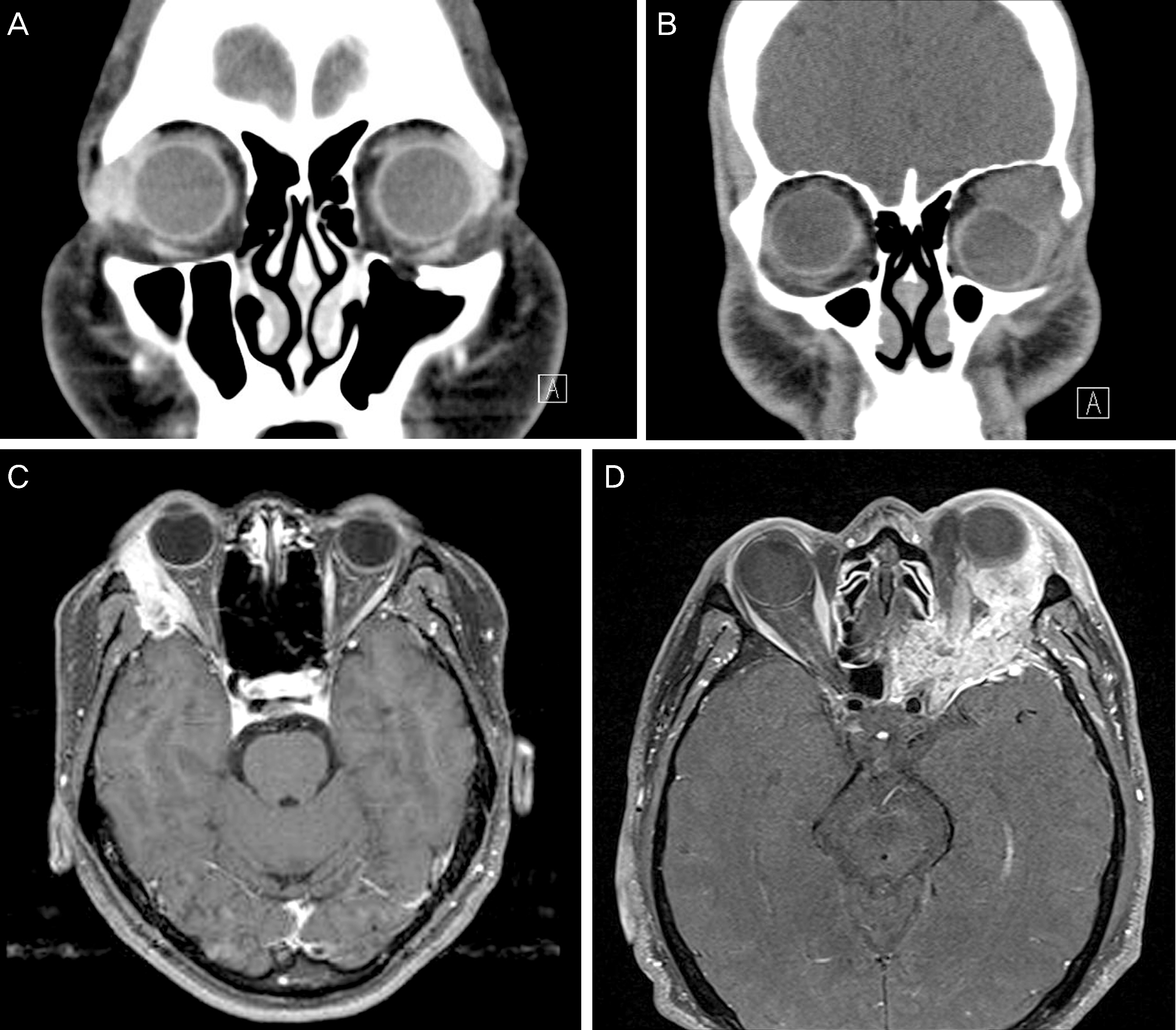J Korean Ophthalmol Soc.
2014 Jun;55(6):795-800.
Clinical Analysis of Epithelial Tumors of the Lacrimal Gland
- Affiliations
-
- 1Department of Ophthalmology and Visual Science, The Catholic University of Korea College of Medicine, Seoul, Korea. yswoph@catholic.ac.kr
Abstract
- PURPOSE
To analyze the clinical and radiologic findings and to evaluate the treatment and prognosis of epithelial tumor patients.
METHODS
We retrospectively reviewed clinical and radiologic findings of 36 patients who had been histopathologically diagnosed with epithelial tumors of the lacrimal gland after biopsy and surgery at Seoul St. Mary's Hospital from May 2005 to October 2012.
RESULTS
Among the patients with epithelial tumors of the lacrimal gland based on histopathological findings, there were 21 cases of pleomorphic adenoma, seven cases of dacryops, four cases of adenoid cystic carcinoma, two cases of adenocarcinoma, one case of benign oncocytoma, and one case of mucoepidermoid carcinoma. The characteristic clinical finding of epithelial tumors of the lacrimal gland was proptosis (52.7%). In contrast with benign epithelial tumors of the lacrimal gland, the characteristic clinical findings of malignant epithelial tumors of the lacrimal gland were limitation of motion (57.1%), diplopia (57.1%), ocular pain (42.9%), and decreased visual acuity (42.9%). The mean duration of the symptoms of malignant epithelial tumors (5.0 +/- 4.2 months) was shorter than that of benign epithelial tumors (11.2 +/- 11.1 months) (t-test, p = 0.034). In radiologic CT and MRI findings, there was minimal bony destruction in two cases of pleomorphic adenoma and calcification in one case of pleomorphic adenoma. Malignant epithelial tumors of the lacrimal gland, in contrast to benign tumors, showed characteristic bony destruction (57.1%), poorly marginated tumor outline (42.9%) and calcification (14.3%). The 57.1% of patients in this study with malignant tumors were treated with chemotherapy and radiotherapy after surgical treatment, and there was one case (14.3%) of recurrence after treatment.
CONCLUSIONS
Careful analysis of clinical and radiologic findings can lead to early diagnosis of malignant tumors.
MeSH Terms
Figure
Reference
-
References
1. Shields JA, Shields CL, Scartozzi R. Survey of 1264 patients with orbital tumors and simulating lesions: The 2002 Montgomery Lecture, part 1. Ophthalmology. 2004; 111:997–1008.2. Kennedy RE. An evaluation of 820 orbital cases. Trans Am Ophthalmol Soc. 1984; 82:134–57.3. Font RL, Croxatto JO, Rao NA. Tumours of the eye and ocular adnexa. AFIP Atlas of Tumor Pathology. Series 4. 5. Washington DC: American Registry of Pathology;2006. p. 111–25.4. Jung JG, Jang JW, Lee SY. The clinical review of epithelial tumors in the lacrimal gland. J Korean Opthalmol Soc. 1999; 40:3258–65.5. Shields CL, Shields JA, Eagle RC, Rathmell JP. Clinicopathologic review of 142 cases of lacrimal gland lesions. Ophthalmology. 1989; 96:431–5.
Article6. Tellado MV, Mclean IW, Specht C, Varga J. Adenoid cystic carci-nomas of the lacrimal gland in childhood and adolescence. Ophthalmology. 1997; 104:1622–5.
Article7. Eviatar JA, Hornblass A. Mucoepidermoid carcinoma of the lac-rimal gland: 25 cases and a review and update of the literature. Ophthal Plast Reconstr Surg. 1993; 9:170–81.8. Rose GE, Wright JE. Pleomorphic adenoma of the lacrimal gland. Br J Ophthalmol. 1992; 76:395–400.
Article9. Heaps RS, Miller NR, Albert DM, et al. Primary adenocarcinoma of the lacrimal gland. A retrospective study. Ophthalmology. 1993; 100:1856–60.10. Lee DA, Campbell RJ, Waller RR, Ilstrup DM. A clinicopathologic study of primary adenoid cystic carcinoma of the lacrimal gland. Ophthalmology. 1985; 92:128–34.
Article11. Zeng J, Shi JT, Li B, et al. Epithelial tumours of the lacrimal gland in the Chinese: a clinicopathologic study of 298 patients. Graefes Arch Clin Exp Ophthalmol. 2010; 248:1345–9.12. Vaidhyanath R, Kirke R, Brown L, Sampath R. Lacrimal fossa lesions: pictorial review of CT and MRI features. Orbit. 2008; 27:410–8.
Article13. Henderson JW, Farrow GM. Primary malignant mixed tumors of the lacrimal gland report of 10 cases. Ophthalmology. 1980; 87:466–75.14. Potter PD, Shield JA, Shield CL. MRI of the Eye and Orbit. 1st ed.Philadelphia: J. B. Lippincott;1995. p. 227–35.15. Hornblass A, Jakobiec FA, Bosniak S, Flanagan J. The diagnosis and management of epithelial tumors of the lacrimal sac. Ophthalmology. 1980; 87:476–90.
Article16. Lai T, Prabhakaran VC, Malhotra R, Selva D. Pleomorphic ad-enoma of the lacrimal gland: is there a role for biopsy. Eye (Lond). 2009; 23:2–6.
Article17. Shields JA, Shields CL. Eyelid, conjunctival, and orbital tumors: An atlas and textbook. 2nd ed.Philadelphia: Lippincott Williams & Wilkins;2008. p. 700–14.18. Polito E, Leccisotti A. Epithelial malignancies of the lacrimal gland: survival rates after extensive and conservative therapy. Annals of Ophthalmology. 1993; 25:422–6.19. Currie ZI, Rose GE. Long-term risk of recurrence after intact ex-cision of pleomorphic adenomas of the lacrimal gland. Arch Ophthalmol. 2007; 125:1643–6.
Article20. Font RL, Smith SL, Bryan RG. Malignant epithelial tumours of the lacrimal gland: a clinicopathologic study of 21 cases. Arch Ophthalmol. 1998; 116:613–6.
- Full Text Links
- Actions
-
Cited
- CITED
-
- Close
- Share
- Similar articles
-
- The Clinical Review of Epithelial Tumors in the Lacrimal Gland
- A Case of Adenoid Cystic CArcinoma of Unusually Located Lacrimal Gland
- Carcinoma expleomorphic adenoma of lacrimal gland
- A Case of Myoepithelial Carcinoma Arising in the Lacrimal Gland
- A Case of Intraorbital Ectopic Lacrimal Gland with Lacrimal Duct


